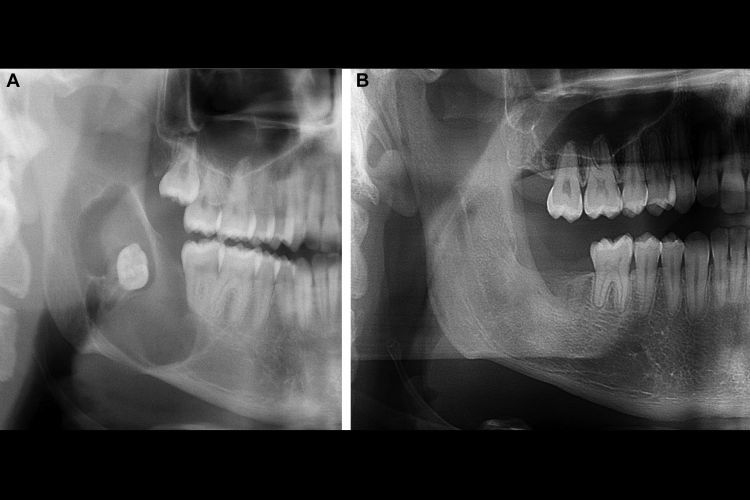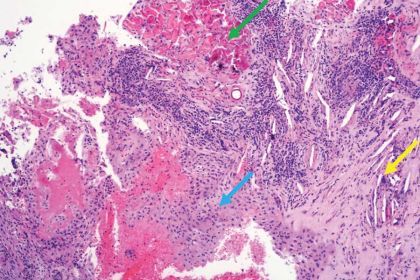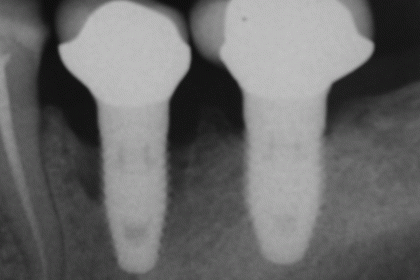Breadcrumb
Refined Topical 5-Fluorouracil Technique for the Targeted Treatment of Odontogenic Keratocysts

Figure 2. Representative example of odontogenic keratocyst treated with refined topical 5-fluorouracil technique. A, Preoperative Panorex radiograph showing a biopsy-confirmed odontogenic keratocyst involving the right mandibular body, and ramus. B, Six-month postoperative Panorex radiograph showing a well-healed, cyst-free right mandible treated with enucleation, peripheral ostectomy, and refined topical 5-fluorouracil technique
What is it?
Odontogenic keratocysts (OKCs) are benign but often aggressive lesions in the jaw. This study represents an investigation of a potentially better way to treat them.
What problem does it aim to solve?
Treatment for OKCs includes application of a drug called 5-fluorouracil (5-FU), which is effective, but the way it is administered, using gauze packing material, is often very uncomfortable/painful for patients, and the gauze may be hard to place correctly if the lesion is too small or in a difficult-to-access location.
How does it work?
Thirteen patients were treated with this new method, in which the surgical cavity was irrigated with saline then covered with topical 5% 5-FU using a cotton swab. The final step was to place absorbable gelatin sponge coated with 5% 5-FU. “This refined technique further increases technical ease, decreases operative time, and precludes the need for packing removal, with similar efficacy as the original approach.”
What are the real-world implications?
If results hold up in subsequent studies over time, this method could be a better way of treating OKCs without having to remove packed gauze.
What are the next steps?
“A well-designed, long-term, prospective, randomized, double-blinded, controlled clinical trial would further support the above findings. A prospective study is currently underway.”
Source
Journal of Oral and Maxillofacial Surgery, Volume 81, Issue 1, January 2023, Pages 95-100, https://is.gd/fequno
Authors
Anthony J. Casino DDS, Clinical Associate Professor, Department of Oral & Maxillofacial Surgery, Stony Brook School of Dental Medicine, Stony Brook, NY
James LeRoy Jr. DMD, Chief Resident, Department of Oral & Maxillofacial Surgery, Stony Brook School of Dental Medicine, Stony Brook, NY
Rekha Reddy DMD, Clinical Assistant Professor, Department of Oral & Maxillofacial Surgery, Stony Brook School of Dental Medicine, Stony Brook, NY
David K.Lam MD, DDS, PhD, Professor & Chair, Department of Oral & Maxillofacial Surgery, Dr. T. Galt and Lee DeHaven Atwood Endowed Professor in Oral and Maxillofacial Surgery, Associate Dean for Medical Integration, University of the Pacific, Arthur A. Dugoni School of Dentistry, San Francisco, CA





